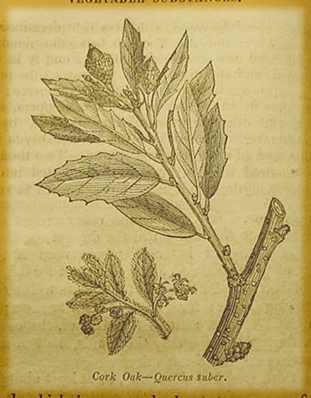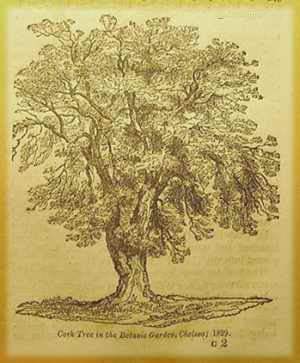
Cork Oak
The Cork Oak Quercus suber is not so large a tree as the common oak. There are several varieties: a broad leaved and a narrow leaved, which are evergreens; besides other varieties which shed their leaves.
The broad-leaved evergreen is the most common, and it is the one from which the cork of commerce is chiefly obtained. It is mentioned by Theophrastus, Pliny, and some other ancient naturalists as being well known in the days of the Greeks and Romans. The Romans used it for many purposes, including the stopping of bottles. They used it as floats for their nets, for bouys for their anchors, and when Camillus swam the Tiber, during the siege by the Gauls, he had a life-preserver of cork under his clothes.
The Cork Oak is abundant in Portugal, Spain, part of the South of France, and Italy; also on the opposite coast of the Mediterranean and the Levant.
Spain and Portugal supply most of the cork which is used in Europe.
The cork is the bark which the tree pushes outwards, as is common to all trees, but here the outer bark is of larger quantity and is renewed more quickly. When removed, there is an inner bark (liber) below it, and fromo this the cork is re-produced in the course of a few years.
The tree is said to grow more vigorously than if the cork was not removed.
The first time the cork is taken off is at the age of about fifteen years. The first crop is thin, full of fissures and not worth much. The second, removed ten years later, is also inferior. After this, the operation is repeated every eight or twn years, the produce being more plentiful and of better quality each time. According to Duhamel, a cork-tree thus barked will live a hundred and fifty years. Cork is removed in July and August.
Woodcuts:

Cork Oak shoot, flower and fruit

Cork Oak in the Botanic Chelsea, 1829.
summarised from "The Library of Entertaining Knowledge - Timber trees" (1829), pub. Charles Knight, Pall Mall.
ND, habitat21
big turbines
small turbines